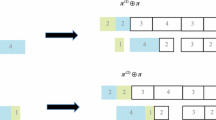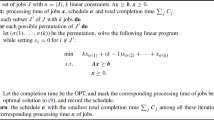Abstract
We consider a job-shop scheduling problem with n jobs and the constraint that at most p<n jobs can be processed simultaneously. This model arises in several manufacturing processes, where each operation has to be assisted by one human operator and there are p (versatile) operators. The problem is binary NP-hard even with n=3 and p=2. When the number of jobs is fixed, we give a pseudopolynomial dynamic programming algorithm and a fully polynomial time approximation scheme (FPTAS). We also propose an enumeration scheme based on a generalized disjunctive graph, and a dynamic programming-based heuristic algorithm. The results of an extensive computational study for the case with n=3 and p=2 are presented.
Similar content being viewed by others
References
Agnetis, A., & Oriolo, G. (1995). The machine duplication problem in a job shop with two jobs. International Transactions on Operational Research, 2(1), 45–60.
Agnetis, A., Flamini, M., Nicosia, G., & Pacifici, A. (2010). Scheduling three chains on two parallel machines. European Journal of Operational Research, 202(3), 669–674.
Akers, S. B. (1956). A graphical approach to production scheduling problems. Operations Research, 4, 244–255.
Baki, M. F., & Vickson, R. G. (2004). One-operator, two-machine open shop and flow shop problems with setup times for machines and weighted number of tardy jobs objective. Optimization Methods and Software, 19(2), 165–178.
Blazewicz, J., Cellary, W., Slowinski, R., & Weglarz, J. (1986). Scheduling under resource constraints–deterministic models. Annals of Operations Research, 7, 1–359.
Brucker, P. (1988). An efficient algorithm for the job-shop problem with two jobs. Computing, 40(4), 353–359.
Brucker, P., Knust, S., & Wang, G. (2005). Complexity results for flow-shop problems with a single server. European Journal of Operational Research, 165, 398–407.
Brucker, P., & Krämer, A. (1996). Polynomial algorithms for resource-constrained and multiprocessor task scheduling problems. European Journal of Operational Research, 90, 214–226.
Carlier, J. (1982). The one-machine sequencing problem. European Journal of Operational Research, 11, 42–47.
Carlier, J., & Pinson, E. (1990). A practical use of Jackson’s preemptive schedule for solving the job shop problem. Annals of Operations Research, 26, 269–287.
Chen, J., & Lee, C.-Y. (1999). General multiprocessor task scheduling. Naval Research Logistics, 46, 57–74.
Cheng, T. C. E., Wang, G., & Sriskandarajah, C. (1999). One-operator two-machine flowshop scheduling with setup and dismounting times. Computers & Operations Research, 26, 715–730.
Garey, M. R., & Johnson, D. S. (1979). Computers and intractability. New York: Freeman.
Glass, C. A., Shafransky, Y. M., & Strusevich, V. A. (2000). Scheduling for parallel dedicated machines with a single server. Naval Research Logistics, 47, 304–328.
Hart, P. E., Nilsson, N. J., & Raphael, B. (1968) A formal basis for he heuristic determination of minimum cost paths. IEEE Transactions on Systems Science and Cybernetics, SSC-4, 100–108.
Ibarra, O. H., & Kim, C. (1975). Fast approximation algorithms for the knapsack and sum of subset problems. Journal of ACM, 22, 463–468.
Kellerer, H., & Strusevich, V.A. (2003). Scheduling parallel dedicated machines under a single non-shared resource. European Journal of Operations Research, 174, 345–364.
Kellerer, H., & Strusevich, V. A. (2004). Scheduling problems for parallel dedicated machines under multiple resource constraints. Discrete Applied Mathematics, 133, 45–68.
Roy, B., & Sussmann, B. (1964). Les problemes d’ordonnancement avec constraintes disjonctives. SEMA, Note D.S., No. 9, Paris.
Sethi, S., Sriskandarajah, C., van de Velde, S., Wang, M. Y., & Hoogeveen, H. (1999). Minimizing makespan in a pallet-constrained flowshop. Journal of Scheduling, 2(3), 115–133.
Sotskov, Y. N., & Shakhlevich, N. V. (1995). NP-hardness of shop-scheduling problems with three jobs. Discrete Applied Mathematics, 59(3), 237–266.
Wang, M. Y., Sethi, S. P., Sriskandarajah, C., & van de Velde, S. L. (1997). Minimizing makespan in a flowshop with pallet requirements: computational complexity. INFOR (Information Systems and Operational Research), 35, 277–285.
Warshall, A. (1963). A theorem on Boolean matrices. Journal of the ACM, 9(1), 11–12.
Wei, V. K. (1981). A lower bound on the stability number of a simple graph. Technical Memorandum No. 81-11217-9. Bell Laboratories.
Author information
Authors and Affiliations
Corresponding author
Additional information
This research was partially supported by the PRIN grant of the Italian Ministry of Education, 2007ZMZK5T.
Rights and permissions
About this article
Cite this article
Agnetis, A., Flamini, M., Nicosia, G. et al. A job-shop problem with one additional resource type. J Sched 14, 225–237 (2011). https://doi.org/10.1007/s10951-010-0162-4
Published:
Issue Date:
DOI: https://doi.org/10.1007/s10951-010-0162-4




